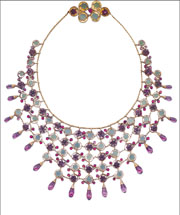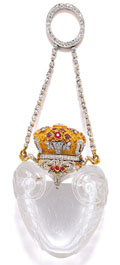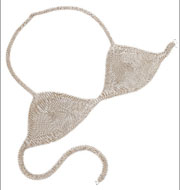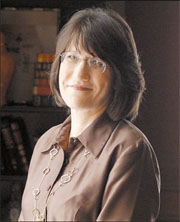There’s such a lot of Tiffany’s world to see

An amethyst fringe necklace.
Schlumberger, the creator of “Bird on a Rock,” a luxury ornament supposedly made out of the world’s largest setting for a yellow diamond, became a Tiffany’s household name.
The bird is one of the pieces featured in a retrospective of the jeweler’s work called “A Diamond in the City” at the Museum of Decorative Art in the Louvre.
And here’s the good news: It comes to Seoul’s Hangaram Design Museum in an exhibit called “The Jewels of Tiffany (1837-2007)” on March 28.
It is one of three major jewelry exhibitions taking place in Korea over the next few months.
Van Cleef Arpels is holding “Jewelry of Eternity” from March 28 to April 4 at Seoul’s Shinsegae Department Store in its Munwha Hall. Cartier is holding “The Art of Cartier” from July 13 to Aug. 22 at the National Museum of Contemporary Art in Deoksu Palace, central Seoul.
The Tiffany and Co. show started at London’s Somerset House in 1996 and it moved to the former residence of Prince Asaka of the Japanese royal family in Tokyo last year.
The show celebrates the Tiffany and Co. brand, which Charles Lewis Tiffany founded in 1837 on Lower Broadway, New York, as a “stationery and fancy goods” store.

A gold perfume bottle.
On show will be a pearl necklace and brooch that Abraham Lincoln gave his wife Mary Todd Lincoln at his presidential inauguration in 1861 and an emerald and diamond brooch once worn as a belt decoration by Empress Eugenie, the wife of Napoleon Bonaparte III.
Each section of the exhibition includes motifs and materials from specific eras.
In “Opulent Accessories,” the exhibition displays exotic fashion souvenirs that were popular in the early 1900s such as fancy canes, a parasol that had a jeweled clock attached to its handle, a perfume bottle crafted from patented Favrile glass and a man’s ornamented cigarette case.
An entire section is devoted to Tiffany’s diamonds and pearls that date from 1870 to the start of World War I. This period was the heyday of diamonds, when Americans invested heavily in the jewelry industry.
There are pink pearls extracted from conch shells that were used to create corsages during the late 19th century, as well as gold, platinum and sapphires that were shown at the Paris Expo in 1889. One of the most precious pieces is a 128.54-carat yellow diamond that the company’s founder purchased. It was stored at Tiffany’s flagship store in New York.
Other works chronicle the history of luxury goods in the West. Included are “Cesnola,” a golden bracelet inspired by ancient Greek jewelry, and a diamond spray brooch designed by Rene Lalique, a leading glass artist of the Art Nouveau period.
The exhibition also celebrates lesser-known works by Tiffany’s designers.
The work of Elsa Peretti, an Italian designer noted for the fluid lines of her stone settings, resonates with radical ornaments shaped like snakes, bones and teardrops.

A halter top brooch
“The Jewels of Tiffany (1837-2007)” is at Hangaram Design Museum from March 28 to June 6.
For more information, call (02) 792-2633 or visit http://designgallery.or.kr.
Diamonds a cut above the rest? Tiffany & Co. thinks so
Annamarie V. Sandecki, the director of Tiffany and Co. Archives, outlines some key events in the development of the company’s history and discusses the highlights of the exhibition.

Annamarie V. Sandecki, the director of Tiffany and Co. Archives. Provided by the organizer
A.The “Tiffany Diamond” in the “Bird on a Rock” setting. It is one of the largest fancy yellow diamonds in the world.
It was discovered in De Beers diamond mines, which used to be called the Kimberley diamond mines, in South Africa in 1877.
The 287.42-carat stone was purchased the following year by Tiffany and Co.
In order to enhance the sparkle, the unprecedented cushion-shape brilliant cut was used. After the cutting, it became 128.54 carats which had 82 more facets than the conventional round brilliant cut.
The stone is just over an inch wide (approx. 2.54 centimeters) and seven-eighths of an inch (approx. 2.2 centimeters) from top to bottom.
The orchid brooches by Paulding Farnham is another one. In 1889 the enameled and diamond orchid brooches designed by the company’s designer Paulding Farnham created a sensation when they won medals at the 1889 Paris Exposition.
What is the significance of orchids?
Orchids in the late 19th century were synonymous with luxury and wealth and these pieces evoke the so-called Gilded Age. They also balance the extreme naturalism of the enameling, accurately recording their coloring, with the abstract designs created by the patterns of the diamonds.
What other jewelry can we expect to see?
We will also be exhibiting works by Louis Comfort Tiffany, the son of founder Charles Lewis Tiffany.
He was already known for his innovative glass and other decorative work when he joined his father’s company as art director in 1907.
In this exhibition, more than 30 pieces of his jewelry are being shown. Highlights include a grapevine fringe necklace made of amethyst and jade set in gold, which was exhibited at the Paris Salon of 1906.
Also included is a group of whimsical brooches with subtle enamel work and lustrous toning gemstones.
Can you tell us about some of the jewelry for men in this exhibit?
There are pocket watches, cufflinks, a cigar cutter and rings. Since the beginning, Tiffany has offered a wide variety of products and I think the exhibit will attract visitors from all walks of life.
In your opinion, what are the greatest strengths of Tiffany and Co. in relation to other luxury jewelry brands?
Tiffany and Co. introduced a unique American style, a departure from the European design aesthetic and the Victorian era’s mannered opulence.
The founder Charles Lewis Tiffany was inspired by the natural world, which he interpreted in exquisite patterns of simplicity, harmony and clarity.
These became the hallmarks of Tiffany design. In our opinion, this style has established Tiffany’s as the arbiter of taste, elegance and sophistication.
By Park Soo-mee Staff Reporter [myfeast@joongang.co.kr]










with the Korea JoongAng Daily
To write comments, please log in to one of the accounts.
Standards Board Policy (0/250자)